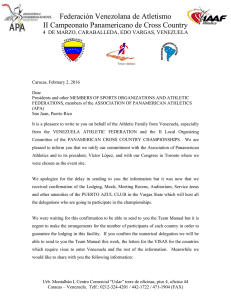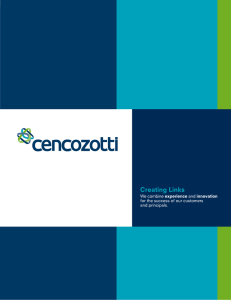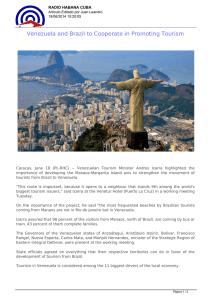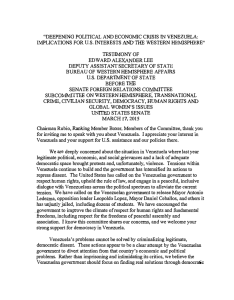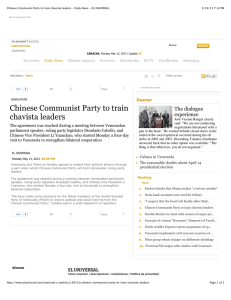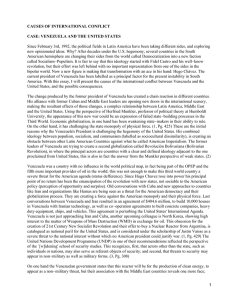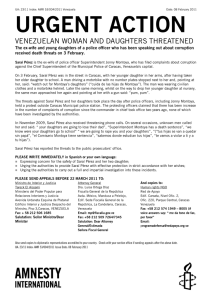Folk-Music Appropriation by Venezuelan Pop Music
Anuncio
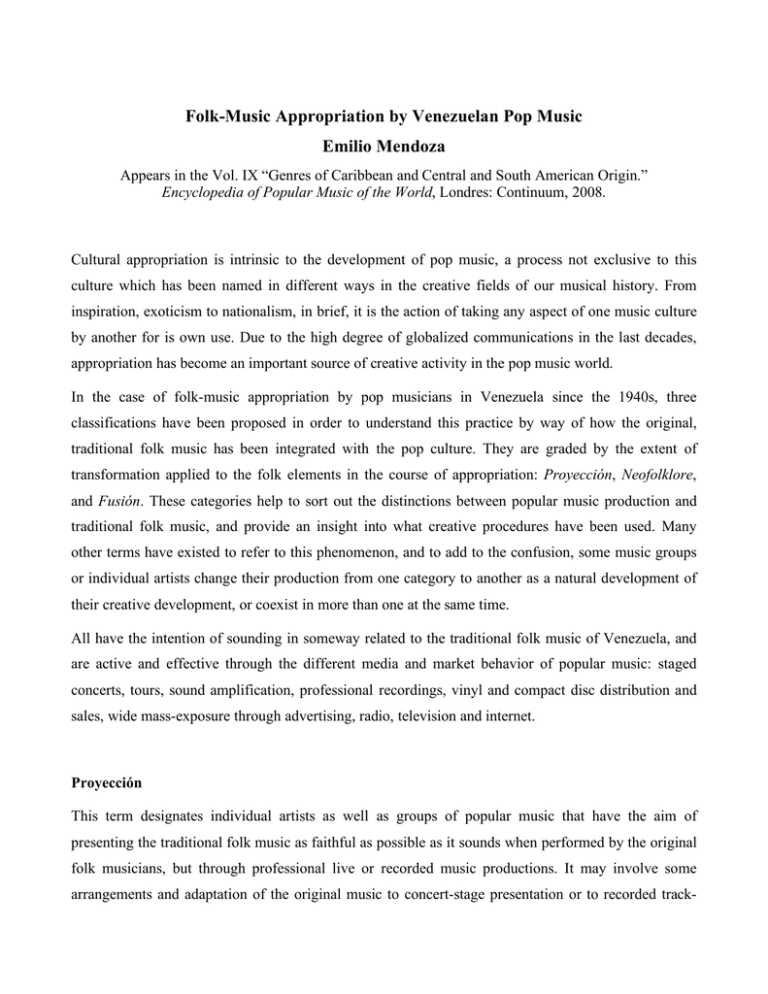
Folk-Music Appropriation by Venezuelan Pop Music Emilio Mendoza Appears in the Vol. IX “Genres of Caribbean and Central and South American Origin.” Encyclopedia of Popular Music of the World, Londres: Continuum, 2008. Cultural appropriation is intrinsic to the development of pop music, a process not exclusive to this culture which has been named in different ways in the creative fields of our musical history. From inspiration, exoticism to nationalism, in brief, it is the action of taking any aspect of one music culture by another for is own use. Due to the high degree of globalized communications in the last decades, appropriation has become an important source of creative activity in the pop music world. In the case of folk-music appropriation by pop musicians in Venezuela since the 1940s, three classifications have been proposed in order to understand this practice by way of how the original, traditional folk music has been integrated with the pop culture. They are graded by the extent of transformation applied to the folk elements in the course of appropriation: Proyección, Neofolklore, and Fusión. These categories help to sort out the distinctions between popular music production and traditional folk music, and provide an insight into what creative procedures have been used. Many other terms have existed to refer to this phenomenon, and to add to the confusion, some music groups or individual artists change their production from one category to another as a natural development of their creative development, or coexist in more than one at the same time. All have the intention of sounding in someway related to the traditional folk music of Venezuela, and are active and effective through the different media and market behavior of popular music: staged concerts, tours, sound amplification, professional recordings, vinyl and compact disc distribution and sales, wide mass-exposure through advertising, radio, television and internet. Proyección This term designates individual artists as well as groups of popular music that have the aim of presenting the traditional folk music as faithful as possible as it sounds when performed by the original folk musicians, but through professional live or recorded music productions. It may involve some arrangements and adaptation of the original music to concert-stage presentation or to recorded track- Folk-Music Appropriation: Proyección, Neofolklore, Fusión time limits, in the way of introductions, solos, end codas and small changes in the formal structure. Priority is always given to the employment of the same instruments as in the original version. Composing new lyrics within the traditional harmonic and rhythmic formats, as well as composing new songs maintaining a close relation to the traditional style, are part of the same objectives of mass-media promotion of the traditional music. These musicians often refer to their activity as a ‘rescate-type’ of amateur research: attribute to themselves the function of ‘rescuing’ the Venezuelan traditional music from being forgotten, through their promotional activity. Because of mass-media exposure and its better sound quality for media reproduction, their music productions may substitute the original folk music as a sound source for reference of identity and values at the national level. The performances of proyección music can take place in any concert hall, anytime of the year, allowing this folk-substitute to be consumed, released from its cultural, time-place relationship. In a similar practical way, one single artist or group may include in a performance many different folk genres, although it is also common that a grupo de proyección specializes in only one folk genre, as the Afro-Venezuelan music, commonly known as grupos de tambor (drum groups). The characteristics of música de proyección can be resumed in the following points: 1. Professional music productions (live and recorded) of traditional folk music. 2. Same instruments as in the original version. 3. Small structural and formal adaptations for professional formats. 4. Adaptation of time scales for media formats. 5. May include new lyrics and music, closely kept within the style. 6. Independent of fixed calendar/place occurrences of the folk festivities. 7. Original function of folk expression changed to pedagogical, entertainment and money-making. 8. Single artist or group may perform mixed folk genres. 9. Popular music behavior: professional quality in recordings and in performance productions, staged concerts, sound amplification, artist-audience relationship, vinyl/CD making, tours, sales-oriented market-strategy development. 10. Attitude of being ‘rescuers’ of folk music. 11. Substitution of the original folk music as reference for identity and values at the national level. One of the first grupo de proyección that made an impact in the popular music of Venezuela was the ‘Grupo Madera’ in 1978. Unfortunately, all of its members except three were drowned in the Orinoco River during a tour in 1980, but a new ‘Madera’ was revived in the beginning of the 1990s. ‘Un Solo Pueblo’ from 1976, headed a large list of groups that flourished in the mid 1970s and 1980s performing 2 Folk-Music Appropriation: Proyección, Neofolklore, Fusión Afro-Venezuelan traditional folk music, becoming successful with the nation-wide insertion of the parranda music from the Barlovento region at Christmas time. Simón Díaz as a solo llanero singer has an extensive production since 1961, and has become an identity figure of Venezuelan culture achieved through his recordings of tonadas. Many solo artists, like Simón Díaz, work around the representation of folk music as a niche of their popular music careers, specially joropo singers, and although they fit perfectly in this category, they are too many to be named here. In grupos de proyección there is a marked difference between all-genre and single-genre groups. The all-genre proyección groups have a more pedagogical orientation in their concerts, with the support of slides, verbal explanations and a structured program by regions or instrumental families. All-genre proyección groups were lead by ‘Convenezuela’ from 1974, concentrating in Venezuelan folk music of all kinds, and by the ‘Orquesta de Instrumentos Latinoamericanos – Odila’ which started in 1982. This large ensemble concentrated in performing music with the original instruments from the whole of Latin American and the Caribbean, based on the audiovisual information and the collection of instruments from the ‘Instituto Interamericano de Etnomusicología y Folklore (INIDEF),’ in Caracas. Since 1990, the ‘Vasallos del Sol’ have remained as one of the most important all-genre grupos de proyección, financed by the Fundación Bigott, because of the high professional level in their performances and recording series. However, the polyphonic vocal arrangements and harmonization in their last recordings from 1999 onwards, such as Tibio Calor, come out of the musical procedures of traditional folk music, and the group steps out into the next category of neofolklore with these productions which cannot be considered any longer as traditional folk music. The single-genre grupos de proyección devote themselves to certain musical regions of Venezuela, or to a specific music type or rhythm, becoming the specialists of the chosen genre. Most single-genre proyección groups are found in the Afro-Venezuelan folk tradition, with music from Barlovento, from the central coast states or from the south of the Maracaibo Lake. Another of the Bigott Foundation’s group, ‘Yuruari,’ 2002, had a repertoire consisting only of traditional calipsos de El Callao. ‘Caraota, Ñema y Tajá’ from the Lara state concentrates in the music of the golpe larense. Old merengue music from Caracas are performed by ‘Los Antaños del Stadium’ and ‘Cañón Contigo.’ In the case of the joropo music, whether llanero, central or oriental, and also the calipso groups from El Callao, as well as from other cities of the Bolívar state, they cannot be considered as proyección music although they take part in some of the popular music behavior. They are the folk players themselves in a process of media conversion. 3 Folk-Music Appropriation: Proyección, Neofolklore, Fusión Neofolklore The term neofolklore indicates the use of traditional Venezuelan folk music by popular music artists or groups, in which different instruments and music procedures are used from the original folk music, but main formal, rhythmic, melodic and harmonic elements are maintained so as recognition of the original music is easily achieved. Its intentions are to promote traditional Venezuelan folk music through professional live or recorded music productions, as well as to market the artist’s or group’s performance and arrangement abilities. However, its definition has been diverted since 2005 in its application by disc jockeys of Venezuelan radio stations to generally designate a category in recorded popular music in which any type of appearances of folk music elements exists. This is a result of a new law sanctioned by the Asamblea Nacional (National Assembly) on December 2004, the Ley de Responsabilidad Social de la Radio y Televisión (Law of Social Responsibility of the Radio and Television). The law regulates the amount of hours that radio stations must reserve to transmit music derived from national productions which are defined by having at least 70 percent of Venezuelan staff, performers, investment capital, localities and Venezuelan cultural values. (Gobierno, 2006). Therefore, in order to obtain broadcasting space in radio stations without the ‘payola,’ or at least a fairer treatment, Venezuelan popular music productions of all genres started in 2005 to include folk elements in their music, providing at the same time the music needed by the stations to comply with this category, which was broadly named neofolklore. It has also been lightly used to designate music which is more experimental and progressive in nature, although still using some aspects of the traditional folk music. These cases should be better classified under the next category, fusión. Neofolklore achieves a good balance in sounding different, appealing to a larger media audience, and at the same time still being recognized as belonging to Venezuelan traditional music. Similarly as in the case of música de proyección, it substitutes the original folk music as a sound source for reference of identity and values at national level. The instruments are different from the original folk music, usually in a fixed ensemble which characterizes the music group. Nevertheless, a traditional folk instrument such as the cuatro or the maracas is usually included. Instrumental variations may include changes in performing practices, in instrumental combinations, inclusion of symphonic instruments, arrangements for symphonic orchestra, for choir and for rock/jazz band, use of electronics, amplification and digital technology. Compositional procedures not found in the original folk music are used, including larger changes in formal structures in the way of introductions, interludes and endings, but conserving the original form of the folk music pieces in a considerable proportion. Neofolklore also employs tempo changes, extensive part counterpoint, extended harmonization, instrumental virtuosity and 4 Folk-Music Appropriation: Proyección, Neofolklore, Fusión improvisation in jazz style, change of rhythm while maintaining the melodic and/or harmonic structure or the other way round, collage and fragmentation of original material, mixing of genres, among many other resources. Some of its characteristics coincide with the grupos de proyección since both categories belong to the popular music field: 1. Professional music productions (live and recorded) of traditional folk music. 2. Different instruments and instrumental combinations as original version, but usually presence of one traditional instrument. 3. Larger structural and formal changes, but conservation of considerable part of the original form. 4. Inclusion of different compositional procedures as in the original music. 5. Adaptation of time scales for media formats. 6. May include new lyrics and music, in accordance with style. 7. Independent of fixed calendar/place occurrences of the folk expression. 8. Original function of folk expression changed to entertainment and money-making. 9. Single artist or group may perform different folk genres. 10. Popular music behavior: professional quality in recordings and in performance productions, staged concerts, sound amplification, artist-audience relationship, vinyl/CD making, tours, sales-oriented market-strategy development. 11. Substitution of the original folk music as reference for identity and values at the national level. The first neofloklore practices can be accounted to the more than 300 transcriptions and arrangements of Venezuelan folk music to choir, piano or guitar by the composer and music-leader Vicente Emillio Sojo, which he began in 1937. Although intended for academic music disciplines because of its time context, the many different recordings of his arragements have become popular music and influenced the whole development of neofloklore thereafter. One of the first major groups in this category was the ‘Quinteto Contrapunto,’ a mixed-vocal ensemble from 1962, which set the trend not only for later choir contrapuntal arrangements of folk music, but also for the instrumental ensembles that flourished from the 1980s onwards. The distinct voices of Jesús Sevillano and Morela Muñoz characterized this famous vocal quintet, the latter being a soprano with formal training. They were followed in the 1970s with the exact formula by ‘Serenata Guayanesa,’ an all-male voice quartet. The main instrumental ensembles, among many others, are ‘El Cuarteto’ (1978) and ‘Ensamble Gurrufío’ (1984), both having the concert flute as their main melodic instrument. Since 1975, a large youth orchestral movement in Venezuela began to grow, reaching national proportions with well over 160 orchestras after 33 years. The prevalence of symphonic instruments in the country since the mid 1970s was a key factor to the 5 Folk-Music Appropriation: Proyección, Neofolklore, Fusión development of neofolklore and fusion groups of hybrid instrumental combinations (folk and symphonic instruments), specially with instruments such as the traverse flute, clarinet and oboe, which are absent from the traditional folk music instrumental. The use of symphonic instruments to perform traditional folk arrangements is one of the main lines of expansion in Venezuelan neofolklore, which incorporates a level of musicianship and instrumental virtuosity never heard before, and this procedure was pioneered by the ‘Quinteto Contrapunto.’ The flute has gained a renowned position as the flauta venezolana (Venezuelan flute), through the success of the above-mentioned ensembles, based on a neofolklore music repertoire with demanding virtuoso performing techniques. Other instruments are approaching the same direction, such as the violin with Alexis Cárdenas, and the piano in the joropo productions made by Claudia Calderón as well as Prisca Dávila, performing in this instrument exact transcriptions of field recordings of music from joropo central and joropo llanero harp players. The violin already existed in folk music from the Andean region, and the piano joropo had indistinctly survived in the ambience of hotel lounges. However, these new artists have brought in the classicaltrained performance virtuosity within a popular music market. A trend present in many instrumental groups, is to develop their neofolklore practices towards experimenting and creation, which would place them in the next category, fusión music. Afro-Venezuelan groups who devoted themselves to proyección music, have also started to follow the trend to elaborate their music towards neofolklore and fusión, as is the case of ‘Tambor Urbano’ from 1996 onwards. Fusión This term includes new compositions by popular music artists and groups which use elements from the traditional folk music without producing a recognizable traditional folk piece, and which formal, instrumental, language, style and conceptual propositions are different, personal and experimental in nature. Some music inconsistently named with the term neofolklore may apply to this category. Fusión is separate from the nationalist intentions of academic composers, although it involves similar music procedures, because it is active within the field of popular music. Nevertheless, it may be expected that these two domains of music composition, that is, fusión in popular music and nationalism in academic music, will eventually merge since composers of both areas are moving between their boundaries. Fusión artists may be found within a wide spectrum of music propositions, from simple use of a folk rhythm to digital experimentation with folk instruments. It is perhaps too early in its development to be able to group tendencies together, but a recurrent influence similarly as in the neofolklore music, has 6 Folk-Music Appropriation: Proyección, Neofolklore, Fusión been the integration of highly skilled performers of symphonic instruments with the folk and pop music worlds. The main characteristics of this category are: 1. Professional music productions (live and recorded) of new compositions with elements of traditional folk music. 2. No specific folk piece is recognizable 3. Different formal, instrumental, language, style and conceptual propositions from traditional folk music. 4. Personal and experimental in nature. 5. Specific to popular music, although may come into contact with the academic music world. As in neofolklore, the nearest procedure to make music with an scent of traditional folk culture is to use the folk instruments with different music or to use similar-sounding folk music with other non-folk instruments. Antonio Lauro, guitarist-composer, who lead one of the first important popular music groups in 1935, the ‘Cantores del Trópico,’ created many guitar compositions with Venezuelan folk rhythms, such as the series of Valses Venezolanos, the Merengue para Guitarra, Seis por Derecho, Pasaje Aragüeño, among many others. With his guitar compositions, Lauro has become part of the basic program of all classical guitar schools in the world, and at the same time his music has remained very popular despite that the guitar in Venezuelan folk music has never been a prominent instrument, with the exception of a faintly surviving tradition in the joropo central music. The cuatro, as the national instrument, appears in almost all of the country’s folk music, but its role has been always reserved to function as an accompanying instrument. In the 1950s, Freddy Reyna developed it to become a solo virtuoso instrument, transcribing into tablature folk repertoire, publishing a method in 1957 and a series of recordings from then on. Reyna published a new, improved method for the cuatro in 1996, five years before his death. His work was expanded by Hernán Gamboa in the seventies and by Cheo Hurtado, a prominent cuatro virtuoso belonging to the ‘Ensamble Gurrufío,’ from the 1980s onwards. Young cuatro performers are taking the instrument to new frontiers, including jazz, where the folk reference is considerably lessened, as in the case of the new cuatro group, ‘C4 Trío.’ Another instrumental change was achieved by Carlos Guedes, based in Houston, USA, with the amplified and midi harp within a jazz context. Fusión means in Spanish to join or mingle, and in the developing of new popular music it applies preferentially to the mixing of different rhythms to produce a new one. 7 Folk-Music Appropriation: Proyección, Neofolklore, Fusión Aldemaro Romero became famous with his orchestral arrangements of Venezuelan folk and pop music in his album Dinner in Caracas in 1952, but he later mixed the Bossa Nova with Venezuelan rhythms within a band concept and created a new rhythm, the Onda Nueva (New Wave) in 1971, introducing it with the album El Fabuloso Aldemaro y su Onda Nueva. He produced thereafter a long series of L.P. records which always included arrangements of popular music of the world, and his own compositions in this new rhythm. One of the most successful examples of fusión music in Venezuela is the world hit ‘Moliendo Café’ by Hugo Blanco in 1959, the most versioned song of Latin America. Using the cuatro, the Venezuelan joropo llanero harp, the maracas, the first electric bass in the country and the Son clave in 3-2, he invented a song with an intro in the Andalusian cadence and a rhythm with a Caribbean flavor which he named ritmo orquídea. He achieved adapting the two Venezuelan folk string-instruments, the harp and the cuatro, of folk repertoire which is completely ternary-subdivided, to sound in a four-beat, binarysubdivided rhythm. In the late 1960s he expanded his success by producing four young talents from Caracas to form the first Venezuelan Ska group, ‘Las Cuatro Monedas.’ An important popular music group named ‘Guaco’ was formed in 1960 and grew in the west part of Venezuela, in the city of Maracaibo. Using the traditional rhythm of the gaita zuliana as its base, in its different forms which are traditionally performed at Christmas time, ‘Guaco’ succeeded in detaching the gaita from its folk-calendar tradition and creating a personal ‘Guaco sound.’ Further developments of fusión music introduced simultaneously all kinds of changes, including instrumental switching, rhythmic mixing, to changes in the social function and contexts. From 1967, the large production of original canciones de protesta (protest songs) by Alí Primera included the use of Venezuelan folk rhythms and instruments, enhancing the cultural and social relationship of his music. Within the rock influence of the early seventies, Vytas Brenner, of German origin, produced an important track, ‘Frailejón,’ in his record Ofrenda. Here he mixed the harp of the joropo llanero with a rock band. This tendency was immediately followed by the jazz pianist Gerry Weil, from Austria, mixing Venezuelan rhythms in his influential, experimental group ‘La Banda Municipal’ in 1973-74, leaving no recordings. Gerry Weil has continued to produce original fusión music in different instrumental combinations until today, a permanent resident of the country and jazz teacher of generations. 8 Folk-Music Appropriation: Proyección, Neofolklore, Fusión The ‘Odila,’ previously mentioned as a grupo de proyección of Latin American folk music in 1982, included in the second part of its concert program a series of commissioned experimental compositions for a thirty-member orchestra of folk and indigenous instruments. Compositions such as Etnocidio of Emilio Mendoza, its director until 1987, were part of this alternative repertoire, which was bringing together indigenous, folk, pop and academic influences. It was common for solo singers in Venezuela to experiment with folk music in one way or another. María Rivas, a successful jazz singer appearing as soloist in 1987, experimented with Afro-Venezuelan rhythms and joropo folk music. Carlos Baute learnt to play and dance folk music in the Talleres de Música Popular (Workshops of Popular Music) of the Bigott Foundation in Caracas, before adventuring himself in his Orígenes albums of 1994 and 1997. Within Latin-Ska and Reggae, groups such as ‘King Changó’ included an amplified cuatro in the track in their music, such as ‘Confesión’ in 1997, made possible by the new technology of the luthier Luis Ruiz in Caracas of his ‘Gordation’ cuatro series similar to the electro-acoustic Ovations guitars. An additional musical influence from the symphonic, academic world completes the ingredients of the Venezuelan fusión development, which has already been observed in the neofolklore music, as a byproduct of the youth symphonic movement. Academic instrumental virtuosity with extended compositional procedures have reached the production of popular music which is at the same time folk in essense. The neofolklore groups which started in the 1980s eventually progressed to experiment with música de fusión, such as the compositions for ‘El Cuarteto’ and for the ‘Ensamble Gurrufío’ together with symphonic orchestras. ‘Gurrufío’ conducted in 2001 a project known as the ‘Camerata Criolla’, in the same direction as the Odila two decades before, but for a hybrid-chamber ensemble. They commissioned and performed works by composers of both worlds such as Paul Desenne with his El Reto, crossing the border between academic and pop musics with this initiative. Numerous groups and soloists have evolved in the last twenty years and Venezuelan popular music is very active in its production of música de fusión. Some artists which have a sustained a level of production for over ten years, mostly with hybrid ensembles, are ‘Arcano,’ ‘Onkora,’ ‘Saúl Vera y su Ensamble,’ ‘Caracas Sincrónica,’ and the guitarist Aquiles Báez. They give different names to define their music, such as Saúl Vera ‘Música Instrumental Venezolana de Nueva Tendencia’ (Venezuelan Instrumental Music of New Tendency), who incorporates the bandola llanera, a folk relative of the mandolin, to his jazz ensemble. Vera is also active as academic composer completing his Concierto para Bandola y Orquesta (Concert for Bandola and Orchestra) in 2000 and writing a method for the instrument. Andrés Eloy Medina, oboist of Arcano, defines it as ‘Música Venezolana Contemporánea,’ 9 Folk-Music Appropriation: Proyección, Neofolklore, Fusión (Venezuelan Contemporary Music), (Mendoza 2000), where the boundaries in terminology and musicmaking between contemporary academic music and progressive popular music are diffused. The joining of borders between the three music worlds is one of the most important results of the fusión category, as well as the creation and advancement of the new Venezuelan popular music. Some newcomers should be mentioned because of their surprising high level of music production, despite of having recently appeared: ‘C4 Trío,’ the new cuatro music of Venezuela, Huáscar Barradas, a flutist proclaiming and taking advantage of the validity of neofolklore in its general association, ‘Ensamble Catako,’ ‘Akurima,’ ‘Pabellón sin Baranda,’ ‘Kapicúa’ and ‘Ozono Jazz,’ among many others, with propositions that blend influences from folk music, jazz and academic new music. This last group, Ozono Jazz, has developed an adaptation of the joropo-playing technique ‘jalao’ of the bandola llanera to the nylon-string guitar, as in the track ‘Círculos de Aves.’ An initiative called ‘VenezuelaDemo,’ lead by Alejandro Calzadilla, Luis Laya, Raúl Abdueza and Germán Acero, has achieved in producing since 2005 until 2008, twenty four compact discs which include one track of each artist or group of popular music recorded in Venezuela since the year 2000. This valuable collection, covering over 400 artists of all genres, was financed by the government. Its international distributions has just began, which may mean an opening to the world of the new Venezuelan popular music. Bibliography Barradas, Huáscar. Huáscar Barradas. http://www.huascarbarradas.com Blanco, Nelson. 2003. Estudios Musicológicos del Ritmo Orquídea. Unpublished Master’s Degree Thesis in Musicology. Universidad Central de Venezuela, Caracas. Bruzual, Alejandro. 1998. ‘Cantores del Trópico.’ In Enciclopedia de la Música en Venezuela Vol. 1 [Encyclopedia of Music in Venezuela], eds. José Peñín and Walter Guido. Caracas: Fundación Bigott, 278-79. Caroní Music. Caroní Music http://www.caronimusic.com/ Cedeño, Roberto. 1998. ‘Vitas Brenner.’ In Enciclopedia de la Música en Venezuela Vol. 1 [Encyclopedia of Music in Venezuela], eds. José Peñín and Walter Guido. Caracas: Fundación Bigott, 221. Calderón, Claudia. Claudia Calderón El Piano Llanero. http://www.pianollanero.com Delgado, Sergio. 1998. ‘Aquiles Báez.’ In Enciclopedia de la Música en Venezuela Vol. 1 [Encyclopedia of Music in Venezuela], eds. José Peñín and Walter Guido. Caracas: Fundación Bigott, 123. 10 Folk-Music Appropriation: Proyección, Neofolklore, Fusión Doffiny, Felipe. 1998. ‘Banda Municipal.’ In Enciclopedia de la Música en Venezuela Vol. 2 [Encyclopedia of Music in Venezuela], eds. José Peñín and Walter Guido. Caracas: Fundación Bigott, 160. Doffiny, Felipe. 1998. ‘María Rivas.’ In Enciclopedia de la Música en Venezuela Vol. 2 [Encyclopedia of Music in Venezuela], eds. José Peñín and Walter Guido. Caracas: Fundación Bigott, 532. Doffiny, Felipe. 1998. ‘Gerry Weil.’ In Enciclopedia de la Música en Venezuela Vol. 2 [Encyclopedia of Music in Venezuela], eds. José Peñín and Walter Guido. Caracas: Fundación Bigott, 742. Fundación Vicente Emilio Sojo. Catálogo Discográfico de Intérpretes y Compositores Venezolanos [Discographical Catalogue of Venezuelan Performers and Composers]. http://www.catalogofunves.org.ve Gobierno Bolivariano de Venezuela, Ministerio de Comunicación e Información. VenezuelaDemo. http://www.venezuelademo.com Gobierno Bolivariano de Venezuela, Ministerio de Comunicación e Información. 2006. Ley Resorte. Ley de Responsabilidad Social de la Radio y Televisión. http://www.leyresorte.gob.ve Lauro, Antonio. 2001. Works for Guitar Vol. 1-10. Caracas: Caroní Music. Mendoza, Emilio. 2000. ‘La Utilización de Instrumentos Étnicos en la Composición del Arte Musical en Venezuela en la Segunda Mitad del Siglo XX (1965-1999) [The Use of Ethnic Instruments in Venezuelan Art Music Composition in the Second Half of the Twentieth Century (1965-1999)]. Revista Musical de Venezuela 44: 8-91. Moncada, Fredy. 1998. ‘Aldemaro Romero.’ In Enciclopedia de la Música en Venezuela Vol. 2 [Encyclopedia of Music in Venezuela], eds. José Peñín and Walter Guido. Caracas: Fundación Bigott, 560. Musicavenezuela.com. 2001-2007. Musicavenezuela.com. http://musicavenezuela.com/ Naranjo, Alberto. 1998. ‘Carlos Guedes.’ In Enciclopedia de la Música en Venezuela Vol. 1 [Encyclopedia of Music in Venezuela], eds. José Peñín and Walter Guido. Caracas: Fundación Bigott, 695-96. Noi, Oswaldo. 1998. ‘Alexis Cardenas.’ In Enciclopedia de la Música en Venezuela Vol. 1 [Encyclopedia of Music in Venezuela], eds. José Peñín and Walter Guido. Caracas: Fundación Bigott, 304. Ortiz, Manuel Antonio. 1998. ‘Freddy Reyna.’ In Enciclopedia de la Música en Venezuela Vol. 2 [Encyclopedia of Music in Venezuela], eds. José Peñín and Walter Guido. Caracas: Fundación Bigott, 516-17. Ortiz, Manuel Antonio. 1998. ‘Serenata Guayanesa.’ In Enciclopedia de la Música en Venezuela Vol. 2 [Encyclopedia of Music in Venezuela], eds. José Peñín and Walter Guido. Caracas: Fundación Bigott, 609-10. Ortiz, Manuel Antonio. 1998. ‘Simón Díaz.’ In Enciclopedia de la Música en Venezuela Vol. 1 [Encyclopedia of Music in Venezuela], eds. José Peñín and Walter Guido. Caracas: Fundación Bigott, 520-21. 11 Folk-Music Appropriation: Proyección, Neofolklore, Fusión Ortiz, Manuel Antonio. 1998. ‘Vasallos del Sol.’ In Enciclopedia de la Música en Venezuela Vol. 2 [Encyclopedia of Music in Venezuela], eds. José Peñín and Walter Guido. Caracas: Fundación Bigott, 712. Ortiz, Manuel Antonio. 1998. ‘Yuruari.’ In Enciclopedia de la Música en Venezuela Vol. 2 [Encyclopedia of Music in Venezuela], eds. José Peñín and Walter Guido. Caracas: Fundación Bigott, 749-50. Pacoweb. 2008. Pacoweb. http://pacoweb.net Peñín, José. 1998. ‘El Cuarteto.’ In Enciclopedia de la Música en Venezuela Vol. 1 [Encyclopedia of Music in Venezuela], eds. José Peñín and Walter Guido. Caracas: Fundación Bigott, 456-57. Peñín, José. 1998. ‘Ensamble Gurrufío.’ In Enciclopedia de la Música en Venezuela Vol. 1 [Encyclopedia of Music in Venezuela], eds. José Peñín and Walter Guido. Caracas: Fundación Bigott, 543. Peñín, José. 1998. ‘Grupo Madera.’ In Enciclopedia de la Música en Venezuela Vol. 1 [Encyclopedia of Music in Venezuela], eds. José Peñín and Walter Guido. Caracas: Fundación Bigott, 155-56. Peñín, José. 1998. ‘Quinteto Contrapunto.’ In Enciclopedia de la Música en Venezuela Vol. 1 [Encyclopedia of Music in Venezuela], eds. José Peñín and Walter Guido. Caracas: Fundación Bigott, 411-12. Peñín, José. 1998. ‘Saúl Vera.’ In Enciclopedia de la Música en Venezuela Vol. 2 [Encyclopedia of Music in Venezuela], eds. José Peñín and Walter Guido. Caracas: Fundación Bigott, 719-20. Ramos, Graciela. 1998. ‘Paul Desenne.’ In Enciclopedia de la Música en Venezuela Vol. 1 [Encyclopedia of Music in Venezuela], eds. José Peñín and Walter Guido. Caracas: Fundación Bigott, 512. Reyna, Fredy. 1996. Alfa Beta Cuatro. Caracas: Monte Avila Editores, CONAC, FUNDEF. Salazar, Rafael. 1998. ‘Alí Primera.’ In Enciclopedia de la Música en Venezuela Vol. 2 [Encyclopedia of Music in Venezuela], eds. José Peñín and Walter Guido. Caracas: Fundación Bigott, 479-80. Salazar, Rafael. 1986. Música y Folklore de Venezuela [Music and Folklore from Venezuela]. Caracas: Ed. Lisbona. Sangiorgi, Felipe. 1998. ‘Vicente Emilio Sojo.’ In Enciclopedia de la Música en Venezuela Vol. 2 [Encyclopedia of Music in Venezuela], eds. José Peñín and Walter Guido. Caracas: Fundación Bigott, 628-42. Síncopa. 2002-2008. Síncopa The Guide to Venezuelan Music. http://sincopa.com Strauss, Rafael, ed. 1999. ‘Aquiles Báez.’ In Diccionario de la Cultura Popular Vol. 1 [Dictionary of Popular Culture]. Caracas: Fundación Bigott, 45-46. Strauss, Rafael, ed. 1999. ‘Carlos Baute.’ In Diccionario de la Cultura Popular Vol. 1 [Dictionary of Popular Culture]. Caracas: Fundación Bigott, 59-60. Strauss, Rafael, ed. 1999. ‘Hugo Blanco.’ In Diccionario de la Cultura Popular Vol. 1 [Dictionary of Popular Culture]. Caracas: Fundación Bigott, 63-64. Strauss, Rafael, ed. 1999. ‘Convenezuela.’ In Diccionario de la Cultura Popular Vol. 1 [Dictionary of Popular Culture]. Caracas: Fundación Bigott, 161-163. 12 Folk-Music Appropriation: Proyección, Neofolklore, Fusión Strauss, Rafael, ed. 1999. ‘El Cuarteto.’ In Diccionario de la Cultura Popular Vol. 1 [Dictionary of Popular Culture]. Caracas: Fundación Bigott, 172-74. Strauss, Rafael, ed. 1999. ‘Simón Díaz.’ In Diccionario de la Cultura Popular Vol. 1 [Dictionary of Popular Culture]. Caracas: Fundación Bigott, 218-22. Strauss, Rafael, ed. 1999. ‘Dinner in Caracas.’ In Diccionario de la Cultura Popular Vol. 1 [Dictionary of Popular Culture]. Caracas: Fundación Bigott, 223-24. Strauss, Rafael, ed. 1999. ‘Ensemble Gurrufío.’ In Diccionario de la Cultura Popular Vol. 1 [Dictionary of Popular Culture]. Caracas: Fundación Bigott, 240-41. Strauss, Rafael, ed. 1999. ‘Madera.’ In Diccionario de la Cultura Popular Vol. 1 [Dictionary of Popular Culture]. Caracas: Fundación Bigott, 418-21. Strauss, Rafael, ed. 1999. ‘Orquesta de Instrumentos Latinoamericanos, ODILA.’ In Diccionario de la Cultura Popular Vol. 1 [Dictionary of Popular Culture]. Caracas: Fundación Bigott, 518. Strauss, Rafael, ed. 1999. ‘Alí Primera.’ In Diccionario de la Cultura Popular Vol. 1 [Dictionary of Popular Culture]. Caracas: Fundación Bigott, 579-81. Strauss, Rafael, ed. 1999. ‘Quinteto Contrapunto.’ In Diccionario de la Cultura Popular Vol. 2 [Dictionary of Popular Culture]. Caracas: Fundación Bigott, 589-91. Strauss, Rafael, ed. 1999. ‘Serenata Guayanesa.’ In Diccionario de la Cultura Popular Vol. 2 [Dictionary of Popular Culture]. Caracas: Fundación Bigott, 687-90. Strauss, Rafael, ed. 1999. ‘Un Solo Pueblo.’ In Diccionario de la Cultura Popular Vol. 2 [Dictionary of Popular Culture]. Caracas: Fundación Bigott, 768-72. Strauss, Rafael, ed. 1999. ‘Vasallos del Sol.’ In Diccionario de la Cultura Popular Vol. 2 [Dictionary of Popular Culture]. Caracas: Fundación Bigott, 784-86. Venezuelatoda. 2006. Venezuelatoda. http://www.venezuelatoda.org.ve Vera, Saúl. 1993. Método para el Aprendizaje de la Bandola Llanera [Method to Learn the Bandola Llanera]. Caracas: FUNDARTE/Alcaldía de Caracas. Vera, Saúl. 2000. Saúl Vera. http://www.saulvera.arts.ve Discographical References Baute, Carlos. Orígenes. EMI Rodven. 1994: Venezuela. Baute, Carlos. Orígenes II. EMI Rodven. 1997: Venezuela. Blanco, Hugo. ‘Molinedo Café.’ El Nuevo Ritmo Orquídea: La Dama Equis. Palacio LP6050. 1960: Venezuela. Brenner, Vytas. ‘Frailejón.’ La Ofrenda de Vytas. Suramericana del Disco/Velvet LPY0114. 1973: Venezuela. Ensamble Gurrufío – Camerata Criolla. El Reto. Independent Production. 2005: Venezuela. King Changó. ‘Confesión.’ King Changó. Sonorodven. 1997: Venezuela. 13 Folk-Music Appropriation: Proyección, Neofolklore, Fusión Mendoza, Emilio. ‘Emilio Mendoza y Ozono Jazz – Círculos de Aves.’ Venezuelademo 15. Ministerio de Comunicación e Información. 2006: Venezuela. Odila Orquesta de Instrumentos Latinoamericanos. ‘Etnocidio.’ Entre lo Tradicional y lo Contemporáneo. CCPYT-OAS 88005. 1986: Venezuela. Romero, Aldemaro. Dinner in Caracas. RCA Victor. 1952: Venezuela. Romero, Aldemaro. El Fabuloso Aldemaro y su Onda Nueva. Discos Antor. 1971: Venezuela. Various Artists. VenezuelaDemo Vol. 1-24. Gobierno Bolivariano de Venezuela, Ministerio de Comunicación e Información. 2005-08: Venezuela. Vasallos del Sol. Tibio Calor. Fundación Bigott. 1999: Venezuela. Discography Akurima. Bajo un Cielo Toronjil. Independent Production. 2005: Venezuela. Arcano. Música Venezolana. Independent Production. 2001: Venezuela. Báez, Aquiles. … Y su Música. Independent Production. 1987: Venezuela. Barradas, Huascar. La Nueva Onda de la Música Venezolana. HB Records. 1996: Venezuela. Baute, Carlos. Orígenes. EMI Rodven. 1994: Venezuela. Baute, Carlos. Orígenes II. EMI Rodven. 1997: Venezuela. Blanco, Hugo. El Nuevo Ritmo Orquídea: La Dama Equis. Palacio LPS6050. 1960: Venezuela. Brenner, Vytas. La Ofrenda de Vytas. Suramericana del Disco/Velvet LPY0114. 1973: Venezuela. C4 Trío. C4 Trío. Independent Production. 2006: Venezuela. Calderón, Claudia. El Piano Joropo. Fundación Bigott. 2001: Venezuela. Caracas Sincrónica. El Agridulce. Independent Production. 1998: Venezuela. Convenezuela. Música Popular y Folklórica de Venezuela Vol. 1. 1980: Venezuela. Dessene, Paul. Tocatas Galeónicas. Dorian. 1992: Venezuela. Díaz, Simón. Tonadas. Palacio. 1974: Venezuela. El Cuarteto. El Cuarteto. Integra. 1981: Venezuela. Ensamble Gurrufío. …Con la Orquesta Sinfónica Gran Mariscal de Ayacucho. Independent Production. 1999: Venezuela. Ensamble Gurrufío. Camerata Criolla. Independent Production. 2002: Venezuela. Ensamble Gurrufío-Camerata Criolla. El Reto. Independent Production. 2005: Venezuela. Ensamble Catako. Confesión a Las Estrellas. Independent Production. 2001: Venezuela. Guaco. Esta Gaita si está en Algo. CBS-Columbia. 1972: Venezuela. Guedes, Carlos. Churún Merú. Heads Up. 1990: USA. Hurtado, Asdrúbal Cheo. Compadre Pancho. Musicarte. 1993: Venezuela. King Changó. King Changó. Sonorodven. 1997: Venezuela. 14 Folk-Music Appropriation: Proyección, Neofolklore, Fusión Las Cuatro Monedas. Las Cuatro Monedas a Go-Go. Palacio. 1968: Venezuela. Madera. Madera. Top Hits. 1979: Venezuela. Mendoza, Emilio. ‘Emilio Mendoza y Ozono Jazz – Círculo de Aves.’ Venezuelademo 15. Ministerio de Comunicación e Información. 2006: Venezuela. Odila Orquesta de Instrumentos Latinoamericanos. Entre lo Tradicional y lo Contemporáneo. CCPYTOAS 88005. 1986: Venezuela. Odila Orquesta de Instrumentos Latinoamericanos. Magia y Realidad. Independent Production. 1992: Venezuela. Onkora. Con el Tiempo. Independent Production. 1995: Venezuela. Pabellón sin Baranda. Pabellón sin Baranda. Musicarte. 1997: Venezuela. Primera, Alí. Lo Primero de Alí Primera. Cigarrón-Promus. 1973: Venezuela. Quinteto Contrapunto. Música Popular y Folklórica de Venezuela. Polydor. 1962: Venezuela. Rivas, María. Primogénito. CNR Discos. 1990: Venezuela. Romero, Aldemaro. Dinner in Caracas. RCA Victor. 1952: Venezuela. Romero, Aldemaro. El Fabuloso Aldemaro y su Onda Nueva. Discos Antor. 1971: Venezuela. Tambor Urbano. Tambor Urbano. Foca Records. 1996: Venezuela. Un Solo Pueblo. La Música de Un Solo Pueblo. Promus. 1977: Venezuela. Various Artists. VenezuelaDemo Vol. 1-24. Gobierno Bolivariano de Venezuela, Ministerio de Comunicación e Información. 2005-08: Venezuela. Vasallos del Sol. Tibio Calor. Fundación Bigott. 1999: Venezuela. Vera, Saúl. Saúl Vera y Su Ensamble. Sonográfica. 1994: Venezuela. Weil, Gerry. El Quinteto de Jazz. América Promus. 1967: Venezuela. Yuruari. La Fuerza del Calipso. Fundación Bigott FD2669662. 2002: Venezuela. 15
